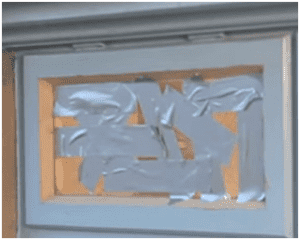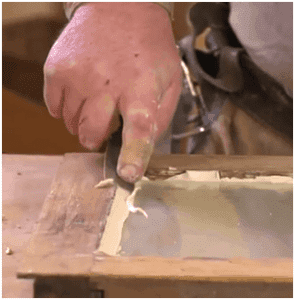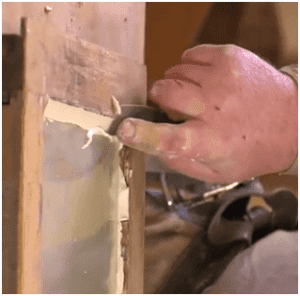Stray football hit the window?
Nasty storm knock a tree branch into the glass?
Whatever the reason, the glass window to that beautiful garden shed has seen its last sunset and now desperately needs replacement. No need to start looking at sheds for sale just yet! However, unlike other household projects that almost certainly need a professional’s help, the repair of a window—particularly a small shed window—requires little in the way of time, skill or money.
One quick trip to the hardware store, a little elbow grease and a splash of encouragement are all that’s need to tackle this project in a single day.
Tools: the basic tools:
- Reliable, heavy-duty leather gloves
- Measuring tape
- Putty knife or old butter knife
- Window Putty
- Razor blade
- Glaze points or small Tacks
- New Glass
OK so before we do our own step by step guide we thought we would also include a video overview to help you.
Step One Preparing the Window: With no experience whatsoever, the average person can figure out the first step in window repair: broken glass removal. Start by putting on those heavy-duty leather work gloves referenced in the tool section and begin excising all of the broken glass from the frame. Work on the larger pieces of the pane first before getting down to the small bits.
If the glass cannot be pulled out by hand, duct tape the pane on the outside of the shed and use a piece of lumber or the top of a hammer to punch the glass out of the frame. Ideally, adorn some form of eye protection if using this means of removal—even a pair of sunglasses are better than nothing.
Continue the cleaning process by removing the existing trim or putty used to hold the old window in place. A stiff putty knife or an old butter knife will aid in this process and assist you in jarring any tiny fragments of glass loose from the frame.
If the window uses trim, do not damage or discard the pieces being removed—they will be necessary later on when installing the new glass. However, if the window only uses only putty and not trim, feel free to be a little more aggressive with the removal process as all old putty will simply be tossed out.
With all of the glass and trim gone, use the razor blade to carefully remove any remaining bits of putty that have thus far refused to move. A slow, gentle shaving motion will help to ensure total removal without damaging the actual frame. Also, double check to make sure that any old glazing points have been completely pulled out and discarded.
Step Two Installation of New Glass: Having meticulously cleaned and prepped the window, it’s time to get underway with the replacement process.
It goes without saying that new glass will be necessary for this project.
Getting properly sized glass is arguably the most important part of this process so pay close attention.
Taking the measuring tape, precisely record the dimensions of the bare frame down to the millimeter. To ensure accuracy, take this measurement at least twice.
Although there’s no reason someone can’t cut their own glass, it’s safer and less stressful to have the glass cut by a professional. Take your measurements to the local hardware store. If your frame is a standard size, they may have ready-cut glass available for purchase. If not, they can typically do a custom cut very quickly and for a small fee. If you live in an area subject to temperature swings or just seasonal temperature extremes, cut the glass 1/8th of an inch shorter & narrower than measured. This will allow the glass to comfortably expand in hot weather.
Having acquired new glass, ready the borders of the frame for installation by applying a generous—but not excessively thick—layer of new putty. Use your fingers or the putty knife to appropriately shape the putty on the frame in a clean manner—individual globs will not do, aim for uniformity.
Also, be sure that there are no gaps in the putty. It needs to run from top to bottom and end to end in an unbroken fashion.
Taking the pane of glass, gently press it into the putty bed lining the frame, taking care to ensure that the pane will stay in place without the support of human hands.
Although some will insist that they are not necessary, it’s strongly recommended that you take glazers points or small tacks to help secure the glass. The points will sit in the frame and work as sturdy buttresses for the glass. Use 2-3 points per side of the frame—so 8-12 in total. If you feel the size of your glass warrants it, use more as necessary.
Friendly Tip: Don’t press on the glass when putting the glazers clips in. Direct 95% of your force downward into the frame.
Step Three Finishing: With the hard work out of the way—and as you can see, it wasn’t that hard, was it?— apply additional putty to the window to secure and weatherproof it (or if your window uses trim, put the trim back on). Shape the final layer of putty into a 45 degree slope to help rain water and condensation run off of the window frame.
Once you’ve done that, go put your tools away because—guess what? You’re all done!




It seems like this is a pretty straightforward process right here. It is a good thing that there are a lot of places that offer glass repair services as well. I would be too afraid of cutting myself to do it by myself.
Scores
Just a bit of wisdom from the old. if you treat glass like it is coming to get you, it will. So, there is no need to be nervous about. Just sayin’
Scores
Thanks for the comment Tim, I expect someone will find that of use. Thanks for taking the time to comment.
Scores
Thank you very much for these instruction on repairing windows. My grandsons were playing catch in the backyard, and one of them overthrew the ball through my garden shed’s window. The list of tools that you provided was very helpful. I’ll make sure to get a putty knife at the store.
Scores